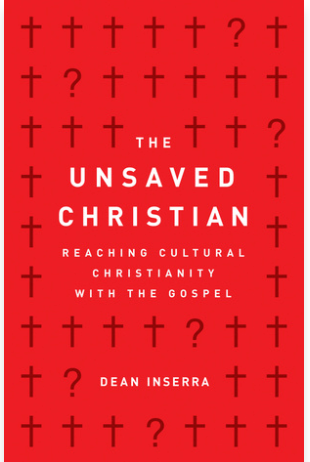I will preface my review by admitting my own tendency toward cynicism when it comes to the traditional conservative evangelical church. In fact, it was that tendency that attracted me initially to this book. Sadly, The Unsaved Christian is merely a rehash of the same narrow traditional conservative viewpoints that I have heard since the 1980s. For example, much of my cynicism stems from the very use of the word “church” and how it shapes our view of what the church is. Repeatedly Inserra refers to the church as a building or a Sunday worship service. It may seem like a picky detail, but

when we fail to use the word “church” to correctly identify a community of believers rather than a place or an event, we only encourage the very cultural Christianity that Inserra is hoping to combat. So, when he says, “We regularly emphasize to the congregation the need to invite friends to church,” he makes an inaccurate distinction between the congregation (which is the church) and the building or event (which is not the church). It also perpetuates the myth that the key to getting people saved is not to “go out” into the world, but to try to attract the world in (so the professional Christians can do the work). If you are like me and see examples like this as part of the problem in the church, then, like me, you will find this to be a frustrating book to read.
On the good side, Inserra identifies several types of “cultural Christians” and expresses grave concerns that their misunderstanding, or more accurately, their lack of understanding, of the gospel endangers their eternal lives. On this, I agree with him, but I find his stereotypical descriptions overly simplistic. In the preface he claims that the book provides a “comprehensive overview of cultural Christianity,” but a truly comprehensive look at each type of cultural Christianity would take far more than the 5 to 6 pages he takes to describe each. Inserra does not deal with nuances, root causes, or the culpability of the church itself, in perpetuating the various types of cultural Christianity, at least not in any detail.
Equally troublesome was the lack of emphasis on discipleship as part of the cure for cultural Christianity. Inserra does allude to discipleship in chapter 9, but reduces discipleship to the same formula that has been used for decades with questionable success – read the Bible, serve in some capacity in church-sponsored programs, get involved in a small group, and go to church-sponsored classes. These are not bad, in themselves, but I have been around a lot of cultural Christians who diligently check all these boxes. To reduce discipleship to participation in these activities misses the point of discipleship and oversimplifies the cure for cultural Christianity. It also perpetuates the myth that all we need to do is get people through the doors and get them involved in order to raise up genuine Christians.
In addition, within the descriptions and approaches to dealing with each type of cultural Christianity, Inserra reveals a narrow view of those who are truly Christian, which basically comes down to only conservative evangelicals. While Inserra repeatedly claims not to be the judge of a person’s salvation, it is clear that he does not believe you can be a Christian without believing in the inerrancy of scripture. Likewise, if you are Catholic or liberal you certainly can’t really be a Christian. That is clearly not the focus of his book, but in talking about cultural Christianity those points are not so subtly made, which repeatedly caused me to cringe while I read.
I appreciate that Inserra is willing to bring cultural Christianity to our attention and his concern for those who falsely believe that they are “in” when they very likely are not, but I believe the subject is dealt with far too narrowly and simplistically in The Unsaved Christian. As someone looking for honest self-reflection from the church, for the sake of doing better, this book falls far short by simply offering more of the same.